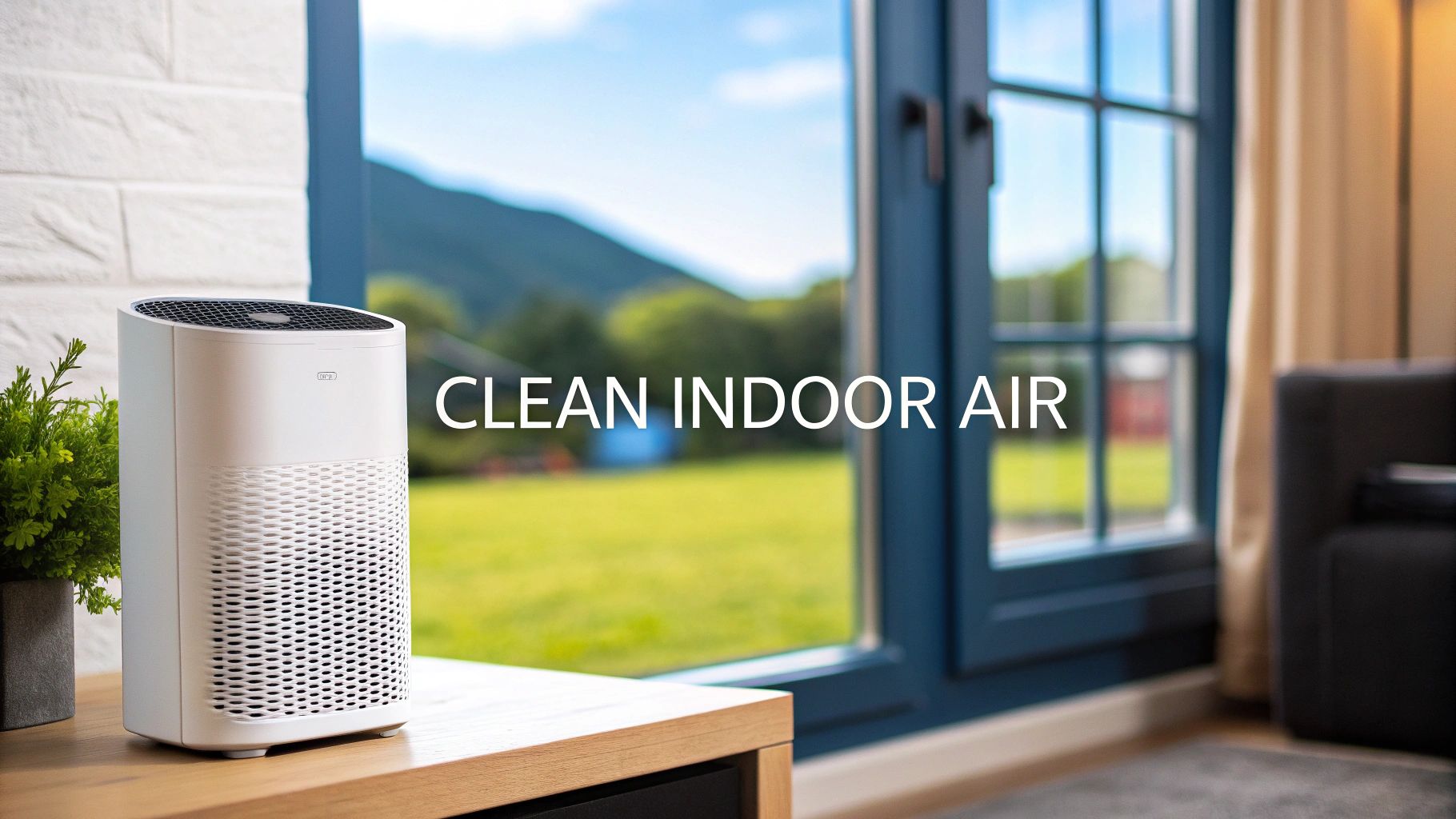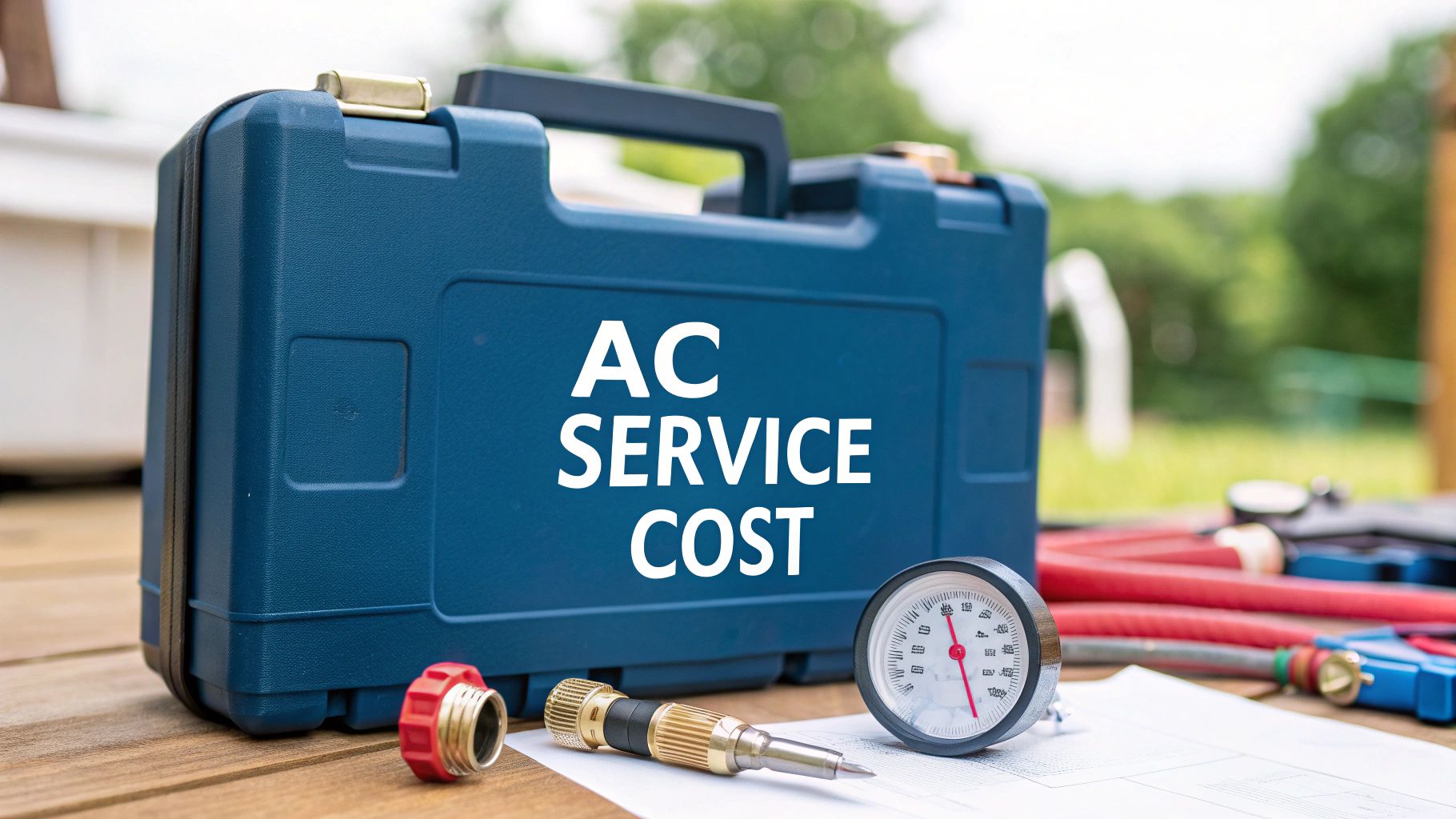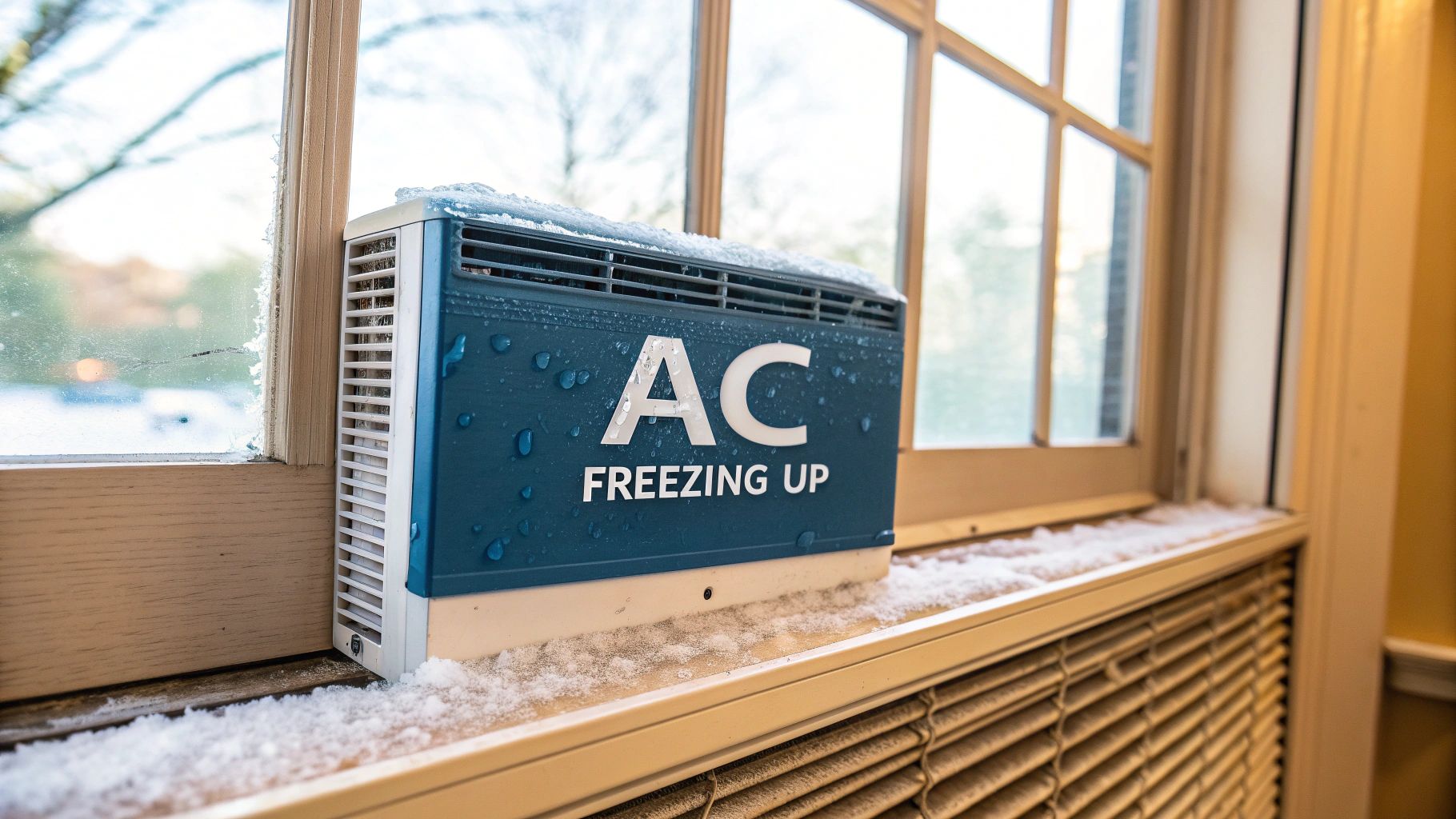The air inside your home or office can be two to five times more polluted than the air outside. From microscopic dust and allergens to invisible chemical vapors from furniture and cleaning supplies, a host of contaminants can impact your health, comfort, and productivity. Achieving significant indoor air quality improvement isn't about a single magic bullet; it's a multi-layered strategy that combines technology, smart habits, and a deeper understanding of your environment.
This guide breaks down ten powerful and distinct methods, providing actionable steps for homeowners and business owners in Palm Beach County. We'll move beyond generic advice to give you specific, practical insights, from leveraging advanced HVAC technology to simple, nature-based solutions. As a foundational step in creating a healthier living space, understanding how regular carpet cleaning can prevent allergies and improve indoor air quality is paramount, as flooring can trap many of the pollutants we'll discuss.
This listicle will explore a range of solutions, including HEPA filtration, proper ventilation, humidity control, and even the strategic use of indoor plants. Whether you're dealing with Florida's high humidity or looking to create a healthier space for your family or employees, these proven strategies will help you take control and breathe cleaner, fresher air.
1. HEPA Air Filtration Systems
High-Efficiency Particulate Air (HEPA) filters are the gold standard for purifying indoor air. These mechanical filters operate by forcing air through an extremely fine mesh, capturing an impressive 99.97% of airborne particles that are 0.3 micrometers or larger. This includes common irritants like dust, pollen, pet dander, and mold spores that can compromise your home or business environment.
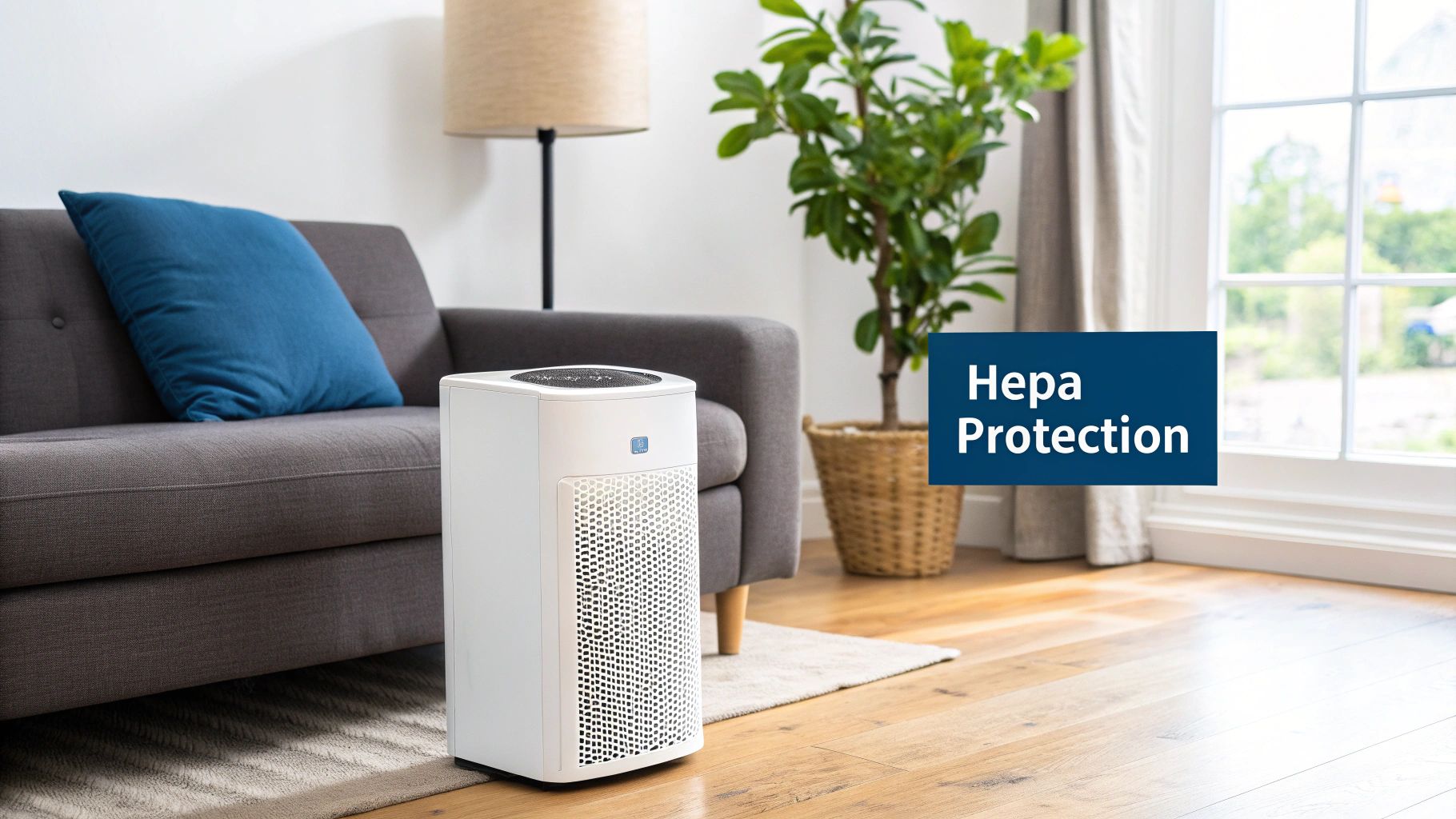
This technology is a cornerstone of modern indoor air quality improvement strategies. You'll find HEPA filtration used everywhere from hospitals and data centers, which require sterile environments, to schools and residential homes using standalone purifiers from brands like Coway or Blueair. The primary benefit is a significant reduction in allergens and other harmful particulates that can trigger asthma, allergies, and other respiratory issues.
How to Implement HEPA Filtration
To get the most out of a HEPA system, strategic placement and maintenance are key. Follow these actionable tips for the best results:
- Placement is Crucial: Position standalone air purifiers in high-traffic areas or rooms where you spend the most time, such as bedrooms and living rooms.
- Contain the Air: Keep doors and windows closed in rooms where a purifier is running to prevent clean air from escaping and new pollutants from entering.
- Mind the Filter: Check your unit’s filter monthly. A clogged filter can't do its job effectively, so replace it according to the manufacturer's guidelines to maintain performance.
- Size it Right: Ensure the unit’s Clean Air Delivery Rate (CADR) matches your room's square footage for optimal air circulation and purification.
By integrating a HEPA filter, you create a powerful defense against microscopic airborne threats. To delve deeper into how different filters can be used, you can explore various filters for air vents in your home.
2. Activated Carbon Filtration
While HEPA filters excel at trapping solid particles, activated carbon filtration targets gaseous pollutants, chemicals, and odors. This technology uses a highly porous form of carbon that has been treated to increase its surface area. It works through a process called adsorption, where volatile organic compounds (VOCs), smoke, and other chemical contaminants chemically bond to the carbon's surface, effectively removing them from the air.
Activated carbon is a crucial component of a comprehensive indoor air quality improvement plan, especially for eliminating invisible threats like formaldehyde from new furniture or fumes from cleaning products. Premium air purifier brands like Dyson and IQAir often combine carbon layers with HEPA filters for all-in-one protection. You'll also find activated carbon in kitchen range hoods to neutralize cooking odors and in commercial buildings to manage chemical pollutants.
How to Implement Activated Carbon Filtration
To maximize the effectiveness of activated carbon, consider its unique properties and how it interacts with its environment. Follow these tips for the best results:
- Target the Source: Place carbon-based purifiers in areas with high concentrations of VOCs or odors, such as kitchens, newly painted rooms, or rooms with new furniture.
- Combine with HEPA: For complete purification, use a system that integrates both HEPA and activated carbon filters. The HEPA filter traps particles, which extends the life and efficiency of the carbon filter.
- Replace Regularly: Carbon filters become saturated over time and lose their ability to adsorb pollutants. Replace them according to the manufacturer’s schedule, or more frequently in high-pollution areas.
- Consider Natural Options: For smaller, enclosed spaces like closets or bathrooms, activated bamboo charcoal bags offer a passive, cost-effective way to absorb odors and moisture.
By adding activated carbon to your air purification strategy, you can effectively tackle the chemical and odor-based pollutants that particle filters miss.
3. Proper Ventilation and Air Exchange
Proper ventilation is the process of replacing stale, polluted indoor air with fresh outdoor air. This fundamental strategy dilutes and removes indoor contaminants like CO2, volatile organic compounds (VOCs), and moisture before they can build up to unhealthy levels. An effective air exchange system is a cornerstone of any serious indoor air quality improvement plan, ensuring a constant supply of clean air.
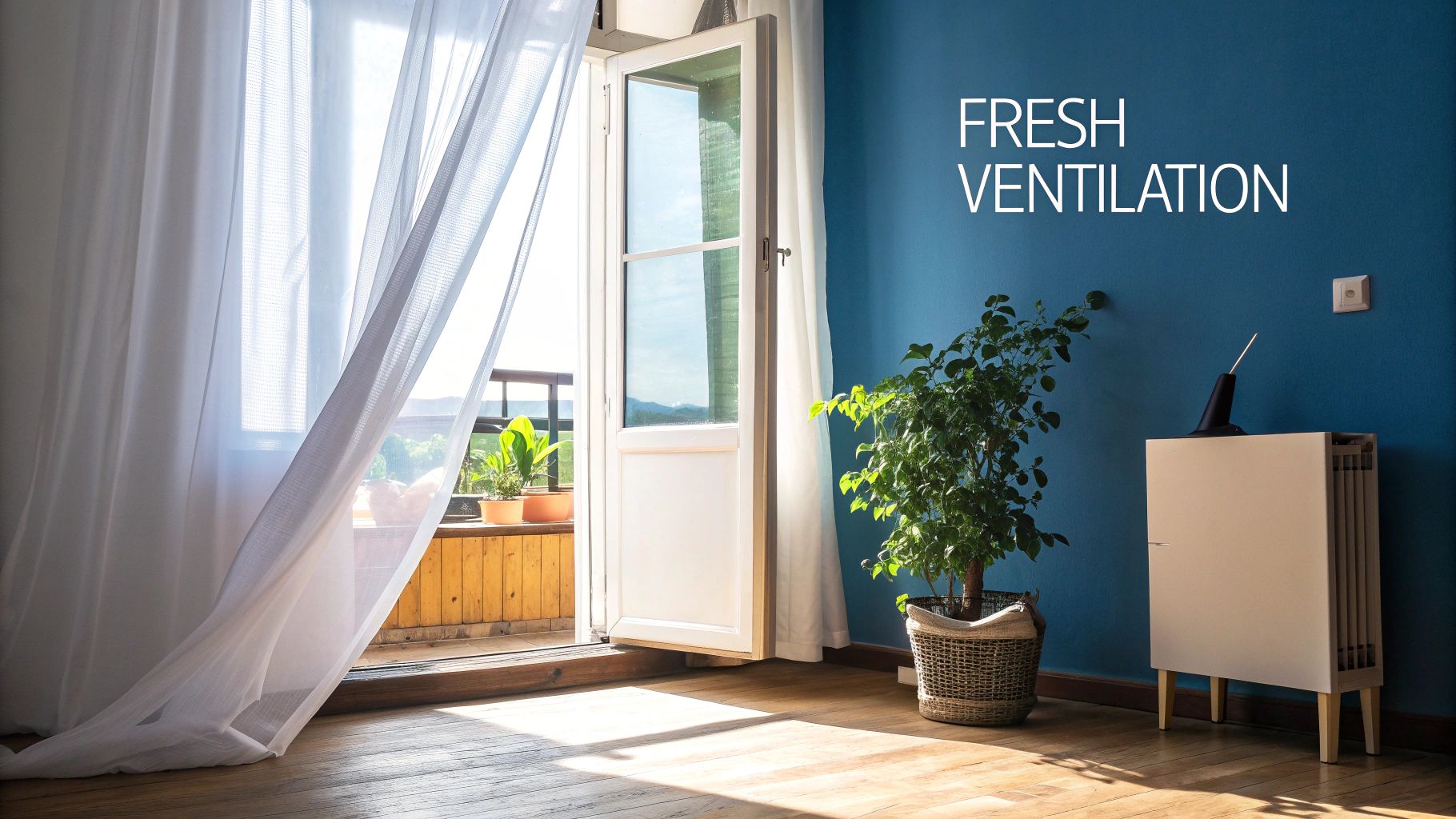
This principle is promoted by organizations like ASHRAE and integrated into certifications such as the WELL Building Standard. Modern solutions range from simple natural ventilation to sophisticated mechanical systems. For instance, Passivhaus buildings use controlled mechanical ventilation to achieve superior air quality, while commercial offices often implement demand-controlled ventilation (DCV) that adjusts based on occupancy, saving energy while maintaining fresh air.
How to Implement Proper Ventilation
Balancing fresh air intake with energy efficiency is achievable with the right approach. Follow these tips to enhance your space's ventilation:
- Practice Natural Ventilation: When outdoor air quality is good, open windows and doors for 15-20 minutes daily to flush out indoor pollutants.
- Use Exhaust Fans: Run exhaust fans in kitchens and bathrooms during and after use to remove moisture and contaminants at their source.
- Install CO2 Monitors: A CO2 monitor is a great tool to gauge whether your space has adequate air exchange; rising levels indicate poor ventilation.
- Consider an ERV/HRV: Energy Recovery Ventilators (ERVs) and Heat Recovery Ventilators (HRVs) bring in fresh air while minimizing energy loss, making them ideal for Florida's climate.
Ensuring your ventilation system is effective also requires unobstructed airflow. You can find more information about how professional duct cleaning services can support air exchange.
4. Indoor Plant Integration
Certain indoor plants offer a natural and aesthetically pleasing way to purify the air by absorbing toxins and releasing oxygen. Pioneering research from the NASA Clean Air Study demonstrated that common houseplants can effectively filter volatile organic compounds (VOCs) like formaldehyde and benzene from the air through their leaves and root systems. While they don't replace mechanical systems, plants serve as an excellent supplementary tool for indoor air quality improvement.
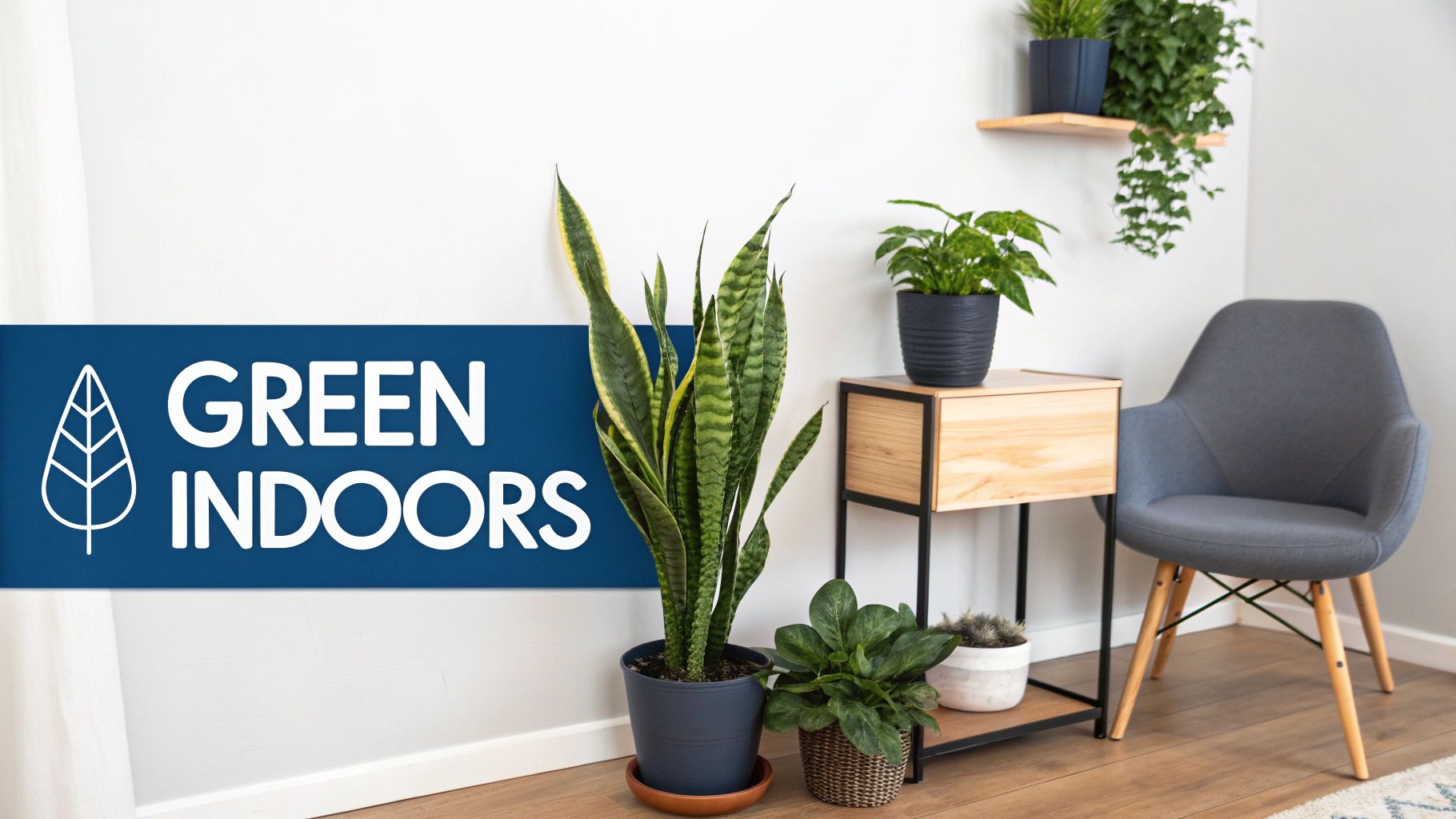
This biophilic approach is used by innovative organizations like Google and in medical facilities to enhance both air quality and occupant wellness. Plants such as snake plants, spider plants, and pothos are particularly effective. Beyond purification, they help regulate humidity and can improve mental well-being, making them a multi-faceted addition to any home or office environment in Palm Beach County.
How to Implement Indoor Plants
To maximize the air-purifying benefits of houseplants, thoughtful selection and care are essential. Follow these practical tips for the best results:
- Diversify Your Greenery: Use a variety of plant species, as different plants are better at filtering specific pollutants.
- Strategic Placement: Position plants in areas with higher potential for pollutants, such as near new furniture, electronics, or in kitchens.
- Check the Light: Most air-purifying plants thrive in indirect sunlight. Check the specific needs of your plants to ensure they stay healthy and effective.
- Water Wisely: Overwatering can lead to mold growth in the soil, which can negatively impact air quality. Let the soil dry out slightly between waterings.
- Keep Leaves Clean: Dust can clog the pores on leaves, reducing their ability to absorb pollutants. Gently wipe them with a damp cloth monthly.
5. Humidity Control and Dehumidification
Managing indoor humidity is a critical, yet often overlooked, aspect of maintaining healthy air quality. The ideal indoor humidity level is between 30% and 50%. When moisture levels are too high, it creates a breeding ground for mold, mildew, dust mites, and bacteria. Conversely, air that is too dry can cause skin irritation, dry sinuses, and cracked wooden fixtures.
Effective humidity control is a cornerstone of any comprehensive indoor air quality improvement plan. You'll see this principle in action everywhere from residential basements using dehumidifiers to prevent musty odors and mold, to hospitals that require precise humidity levels for infection control. Proper management prevents a wide range of respiratory irritants and structural moisture damage, directly contributing to a healthier living and working environment.
How to Implement Humidity Control
Achieving a balanced indoor humidity level involves monitoring and active management. Follow these actionable tips for the best results:
- Monitor Your Levels: Use a hygrometer to measure the humidity in different areas of your home, especially basements, bathrooms, and kitchens.
- Ventilate High-Moisture Areas: Run exhaust fans in bathrooms during and for at least 20 minutes after showers. Ensure kitchen vents are used while cooking.
- Run a Dehumidifier: Place a dehumidifier in damp, poorly ventilated areas like basements or crawl spaces to remove excess moisture from the air.
- Maintain Your HVAC System: Your air conditioner is a powerful dehumidifier. Proper maintenance ensures it operates efficiently. You can learn how to keep your air conditioner coils clean to maximize its dehumidifying capabilities.
6. Source Control and VOC Reduction
One of the most effective strategies for indoor air quality improvement is to eliminate pollutants at their source. This preventive approach, known as source control, focuses on reducing the release of Volatile Organic Compounds (VOCs) and other harmful chemicals before they can contaminate your air. Common sources include new furniture, paints, cleaning products, and adhesives that off-gas chemicals into your environment.
Tackling pollution at its origin is far more efficient than trying to filter it out later. By choosing low-VOC products and materials, you reduce the overall chemical load in your home or business, easing the burden on your HVAC system and air purifiers. This practice is a cornerstone of green building standards, like those from the U.S. Green Building Council (USGBC), which prioritize non-toxic materials to create healthier indoor spaces.
How to Implement Source Control
Integrating source control into your daily life involves making conscious choices about the products you bring into your space. Use these actionable tips to reduce indoor pollutants:
- Choose Low-VOC Products: Look for paints, sealants, and flooring with certifications like Green Seal or GreenGuard Gold to ensure minimal chemical off-gassing.
- Ventilate New Items: Allow new furniture, mattresses, or carpets to air out in a well-ventilated space like a garage for a few days before bringing them inside.
- Switch to Natural Cleaners: Replace harsh chemical cleaners with simple, effective alternatives like vinegar, baking soda, and hydrogen peroxide. When implementing source control, opting for non-toxic carpet cleaning methods can also significantly reduce chemical off-gassing.
- Avoid Synthetic Fragrances: Air fresheners, scented candles, and fabric sprays often release a cocktail of VOCs. Opt for essential oil diffusers or natural methods instead.
7. Air Quality & CO2 Monitoring and Management
You can't manage what you can't measure. Real-time indoor air quality (IAQ) and CO2 monitors provide the data you need to understand and control your environment. These devices use integrated sensors to track key pollutants like PM2.5, VOCs, and carbon dioxide, giving you a clear picture of the air you breathe.
Monitoring is a critical step for effective indoor air quality improvement. Elevated CO2 levels, for example, are a direct indicator of poor ventilation. By tracking this data, homeowners can know precisely when to open a window, while businesses can automate their HVAC systems for demand-controlled ventilation. Devices from brands like Awair or Airthings make this technology accessible, helping you identify problems and verify that your solutions are working.
How to Implement Air Quality Monitoring
Effective monitoring requires more than just plugging in a device. Proper setup and data interpretation are essential for making meaningful improvements.
- Strategic Placement: Position monitors in the "breathing zone," about three to six feet off the floor in frequently used rooms like bedrooms or office spaces.
- Track Over Time: Don't just look at a single reading. Monitor trends during different times of the day and periods of high occupancy to identify patterns.
- Use Data to Act: Let CO2 spikes trigger you to open windows or increase mechanical ventilation. If PM2.5 levels rise, check outdoor air quality before introducing outside air.
- Automate Where Possible: For businesses or smart homes, integrate IAQ sensors with your HVAC system to automatically adjust ventilation based on real-time occupancy and air quality data.
8. UV-C and Photocatalytic Air Purification
Beyond trapping particles, some technologies actively destroy microscopic threats. Ultraviolet-C (UV-C) light and photocatalytic oxidation (PCO) work at a molecular level to neutralize airborne pathogens and volatile organic compounds (VOCs). UV-C light targets the DNA and RNA of microorganisms like bacteria and viruses, rendering them unable to reproduce, while PCO uses a catalyst (like titanium dioxide) and UV light to create radicals that break down pollutants.
This advanced approach to indoor air quality improvement is trusted in sterile environments like hospitals and data centers. You'll also find it in commercial HVAC systems, where duct-mounted UV-C lamps sanitize air as it circulates, and in high-end portable purifiers. The primary benefit is the elimination of biological contaminants and harmful chemicals that mechanical filters cannot always capture, providing an extra layer of protection against illness.
How to Implement UV-C and PCO Technology
Proper installation and maintenance are critical for both safety and effectiveness. Use these guidelines to integrate this technology correctly:
- Professional Installation is Key: UV-C light can be harmful to skin and eyes. Always have in-duct systems professionally installed to ensure they are properly shielded and operate safely.
- Combine with Filtration: These systems excel at neutralizing germs and VOCs but don't remove particulates. Pair them with HEPA and activated carbon filters for comprehensive air cleaning.
- Annual Bulb Replacement: UV-C lamps lose their germicidal effectiveness over time. Schedule an annual replacement with your HVAC technician to maintain peak performance.
- Verify Safety Certifications: When choosing a portable unit, look for safety certifications (like UL) to ensure it is well-constructed and does not produce harmful ozone as a byproduct.
9. Radon Testing and Mitigation
Radon is a naturally occurring, colorless, and odorless radioactive gas that can seep into buildings from the ground. As a leading cause of lung cancer among non-smokers, addressing its presence is a critical component of any serious indoor air quality improvement plan. Radon accumulates in enclosed spaces, particularly basements and ground-floor rooms, posing a silent but significant health risk.
Testing is the only way to know if your property has elevated radon levels. If concentrations are high, mitigation systems, such as sub-slab depressurization, are installed to safely vent the gas outside before it can enter your living space. This practice is now standard in new construction in high-risk areas, like parts of the Midwest and Northeast, and is often required during real estate transactions to protect occupants.
How to Implement Radon Testing and Mitigation
Proactively managing radon risk is straightforward with the right approach. Follow these essential tips to ensure a safe indoor environment:
- Test Your Property: Purchase a DIY radon test kit or hire a certified professional. The initial short-term test should be placed in the lowest lived-in level of your home for at least 48 hours.
- Know When to Act: The EPA recommends taking action if radon levels are 4.0 picocuries per liter (pCi/L) or higher. If levels are between 2.0 and 4.0 pCi/L, consider a long-term test for a more accurate reading.
- Install a Mitigation System: If levels are high, a qualified contractor can install a mitigation system. This typically involves a vent pipe and fan to draw radon from beneath the foundation and release it outdoors.
- Seal Entry Points: Support your mitigation system by sealing cracks in the foundation, walls, and floors to reduce the pathways for radon to enter your home.
10. Negative Ion Generators and Ionizers
Negative ion generators, or ionizers, release electrically charged molecules (ions) into the air. These negative ions attach to positively charged airborne particles like dust, pollen, and other pollutants. This process makes the particles heavier, causing them to fall out of the air and settle onto surfaces like floors and furniture, where they can be wiped or vacuumed up.
While this technology can help reduce the number of airborne particles, it's a controversial method for indoor air quality improvement. A significant drawback is that some older or poorly designed models can produce ozone, a known lung irritant. For this reason, ionizers are often used as a supplementary feature in modern air purifiers rather than a standalone solution. They are sometimes found in vehicles or used in specific commercial settings alongside more robust filtration systems.
How to Implement Ionizers Safely
If you decide to use an ionizer, it's critical to do so correctly to avoid potential health risks. Follow these tips for safe and effective use:
- Prioritize Ozone-Free Models: Only choose ionizers that are certified as "ozone-free" by a reputable third-party organization like the California Air Resources Board (CARB).
- Use as a Supplement: Pair an ionizer with a primary filtration system, such as a HEPA filter, which physically traps particles instead of just causing them to settle.
- Clean Surfaces Frequently: Since ionizers cause particles to fall onto surfaces, regular dusting and vacuuming are essential to actually remove the contaminants from your space.
- Ensure Proper Placement: Place the unit on an elevated surface to allow for better distribution of ions throughout the room.
Top 10 Indoor Air Quality Solutions Comparison
| Solution | Implementation Complexity (🔄) | Resources & Cost (⚡) | Expected Outcomes (⭐📊) | Ideal Use Cases (💡) | Key Advantages (⭐) |
|---|---|---|---|---|---|
| HEPA Air Filtration Systems | Low–Moderate 🔄 — portable plug‑and‑play; HVAC integration more complex | $200–3,000 initial; $50–300/yr filters; electricity ⚡ | Very high particle removal (99.97% ≥0.3 μm); reduces allergens and PM ⭐📊 | Bedrooms, allergy/asthma homes, hospitals, data centers 💡 | Proven mechanical capture; non‑toxic; broad particle removal ⭐ |
| Activated Carbon Filtration | Low 🔄 — simple cartridge swaps; usually paired with HEPA | $50–200/filter; $100–400/yr replacements; periodic swaps ⚡ | Effective VOC and odor adsorption; limited particle removal alone ⭐📊 | Kitchens, new furniture/paint areas, smoke/chemical odor zones 💡 | Removes gases/odors HEPA cannot; complements mechanical filters ⭐ |
| Proper Ventilation & Air Exchange | Low–High 🔄 — open windows simple; mechanical retrofits complex | Minimal for natural; $500–5,000 for mechanical/ERV upgrades ⚡ | Dilutes pollutants, lowers CO2 and humidity; foundational IAQ improvement ⭐📊 | Whole‑building IAQ, schools, offices, moisture‑prone homes 💡 | Broad pollutant dilution; prevents mold; energy‑efficient if designed ⭐ |
| Indoor Plant Integration | Low 🔄 — easy placement; requires plant care and maintenance | $10–50 per plant; low ongoing costs (water, light) ⚡ | Supplemental VOC reduction over weeks; psychological and humidity benefits ⭐📊 | Biophilic offices, living rooms, supplement to filtration systems 💡 | Low‑energy, aesthetic, improves wellbeing and humidity regulation ⭐ |
| Humidity Control & Dehumidification | Low–Moderate 🔄 — portable units simple; whole‑home moderate | $200–800 portable; $1,500–3,500 whole‑home; increased energy use ⚡ | Controls mold/dust mites; improves comfort and reduces allergens ⭐📊 | Basements, bathrooms, humid climates, data centers 💡 | Prevents mold, protects materials, enhances comfort ⭐ |
| Source Control & VOC Reduction | Low–Moderate 🔄 — behavioral and procurement changes required | $50–200 higher upfront for low‑VOC products; long‑term savings ⚡ | Reduces pollutant generation at origin; lowers lifetime exposure and filtration load ⭐📊 | Renovations, new furniture, green buildings, occupant health focus 💡 | Most effective long‑term strategy; reduces need for mechanical fixes ⭐ |
| Air Quality & CO2 Monitoring & Management | Low–High 🔄 — consumer monitors easy; integrated systems complex | $50–500 consumer; $1,000–15,000+ professional/integrated ⚡ | Objective IAQ data; enables targeted ventilation and automation ⭐📊 | Schools, offices, smart homes, ventilation validation and research 💡 | Data‑driven decisions, automation, and accountability ⭐ |
| UV‑C & Photocatalytic Air Purification | Moderate–High 🔄 — professional install preferred for safety | $300–1,000 portable; $2,000–8,000+ HVAC integration; bulb replacement ⚡ | Strong microbial inactivation; partial VOC breakdown; not particle capture alone ⭐📊 | Healthcare, high‑risk zones, HVAC pathogen control, high‑traffic areas 💡 | Effective germicidal action; reduces biological contaminants ⭐ |
| Radon Testing & Mitigation | Low–Moderate 🔄 — testing simple; mitigation requires professionals | $150–300 testing; $1,200–2,500 mitigation installation; fan energy ⚡ | Reduces radon 50–99%; significantly lowers lung cancer risk where present ⭐📊 | Basements/ground floors in high‑radon areas; real‑estate transactions 💡 | Addresses a serious health hazard with reliable mitigation methods ⭐ |
| Negative Ion Generators & Ionizers | Low 🔄 — plug‑in devices; minimal setup | $50–300; no filters but may need ozone monitoring ⚡ | May reduce airborne particles via deposition; inconsistent evidence 📊 | Supplementary use in low‑risk spaces; where silent operation desired 💡 | Low cost, no consumables, silent and portable; effectiveness debated ⭐ |
Creating Your Personalized Clean Air Strategy
Navigating the world of indoor air quality improvement can feel overwhelming, but it doesn't have to be. After exploring everything from advanced HEPA and Activated Carbon filtration to the natural power of indoor plants and strategic ventilation, the path forward is clearer. The most crucial takeaway is that there is no single magic bullet; true, lasting change comes from building a personalized, layered strategy that addresses the unique challenges of your home or business.
Think of each tip in this guide as a tool in your clean air toolkit. Your goal is not to use every tool at once, but to select the right ones for the job. Is your primary concern the seasonal pollen that plagues Palm Beach County? Combining a high-MERV filter in your HVAC system with a portable HEPA purifier in the bedroom can create a powerful allergen defense. Are you battling the persistent humidity and musty odors common in our coastal climate? A whole-home dehumidifier integrated with your HVAC is a game-changer, working in tandem with proper ventilation to keep mold and mildew at bay.
From Knowledge to Action: Your Next Steps
The journey to better air begins with assessment. A simple first step is to walk through your space and identify potential pollution sources. Do you notice lingering cooking smells, a dusty film on surfaces, or high humidity levels? This initial audit will help you prioritize.
Here’s a simple, actionable plan to get started:
- Start with the Foundation: Your HVAC system is the heart of your home's air circulation. Begin by checking your air filter. Is it clean? Is it the right type for your needs? This is the single most impactful and cost-effective first step for immediate indoor air quality improvement.
- Identify Your Top 1-2 Priorities: Based on your assessment, choose the most pressing issues. For a family with asthma, allergen control via HEPA filtration is paramount. For a newly renovated office, reducing VOCs with activated carbon filters and increased ventilation should be the focus.
- Implement and Monitor: Introduce your chosen solutions one or two at a time. Consider an indoor air quality monitor to get real-time data on your progress. This device can provide valuable feedback, showing you how opening a window, running a purifier, or even cooking dinner affects your environment.
Key Insight: A proactive and layered approach transforms air quality from an afterthought into a cornerstone of a healthy living environment. By combining source control, proper ventilation, and targeted filtration, you create a resilient system that actively works to protect you and your family.
Ultimately, mastering your indoor air quality is about taking control of your environment. It’s an investment in your health, comfort, and peace of mind. The air you breathe inside should be a source of vitality, not a hidden hazard. By thoughtfully applying these strategies, you can create a sanctuary where every breath is fresh, clean, and restorative.
Ready to take the first and most critical step toward cleaner air? The professionals at Florida Cooling Group are experts in diagnosing and solving indoor air quality challenges specific to our South Florida climate. Schedule a consultation today, and let us help you build a customized filtration and ventilation strategy that works for your home or business.
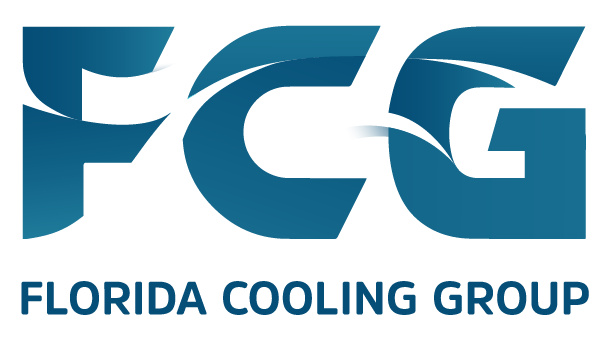
 (561) 400-2205
(561) 400-2205